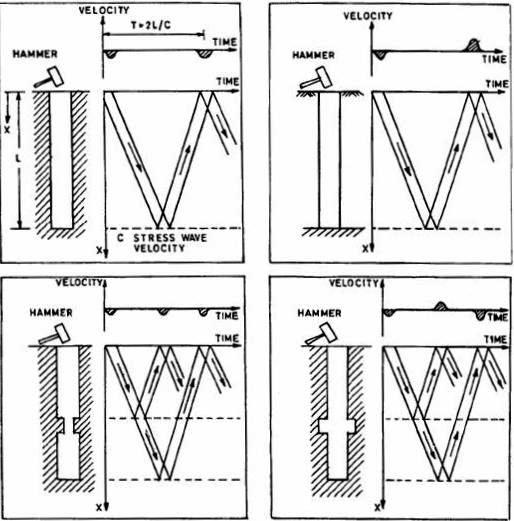Pulse / Sonic Echo Method )(IS-14893:2001, ASTM D-5882-16
Principle & Procedure

- Hammer impact on the surface and a receiver monitors reflected stress wave. Time domain analysis used to determine travel time.
- Based on One Dimensional Stress Wave approach, a low strain integrity testing
- The pile head motion is measured as a function of time. The time domain record is then evaluated for pile integrity.

Pile Integrity Test (Pulse Echo Method )
Significance and use :
- Suitable for – Slender structural elements like structural columns, driven concrete piles, cast in place concrete piles, concrete filled steel pipe piles, timber piles.
- Evaluation of Pile integrity and pile physical dimensions i.e. cross-sectional area, length, continuity, and consistency of the pile material
- Piles shall be trimmed to cut off level or sound concrete level before the test with all laitance removed
- For Pile Dia. > 500 mm additional readings ( @ 3 to 5 Nos ) are required
- Application of Impact shall be within a distance of 300 mm
- The software filters the signal to eliminate High & Low frequencies
- In a few cases where piles are too long or skin fiction is high, low strain method does not provide sufficient information particularly the toe reflection. In such cases high strain method can be used by giving higher impact energies
- The cast-in-situ piles should not be tested normally before 14 days of casting as per IS code & not before 7 days as per ASTM.
- The reasonably correct assessment of Stress Wave Velocity of pile concrete is essential as an input. It is recommended to assess the velocity based on the known length of pile.
- A Complementary Ultrasonic Pulse velocity test may be carried out at the head of the pile in order to arrive at the speed of sound propagation.
- Based on author’s experience, it is not recommended to assume the velocity based on the grade of concrete, mostly as recommended by the instrument manufacturers.
- The test being a low cost and speedy, it is recommended to carry out testing of 100 % piles. The further tests such as Dynamic or Static Load tests may be decided upon the results of Pile Integrity Tests.


Typical Pile Integrity Testing Instrument in use


Defective Piles
Good Pile – PIT Signal
Defective Pile – PIT Signal
Limitations
- Evaluation is approximate and not exact
- No information about load carrying capacity of pile.
- It does not provide information regarding verticality or displacement in position of piles
- Minor deficiencies like local loss of cover, small intrusions or type of conditions of materials at the base of piles are undetectable.
- Integrity testing may not identify all imperfections, but it can be useful tool in identifying major defects within the effective lengths.
- The test may identify minor impedance variations that may not affect the bearing capacity of piles. In such cases, the engineer should use judgment as to the acceptability of these piles considering other factors such as load redistribution to adjacent pile, load transfer to the soil above the defect, applied safety factors and structural load requirements.
- Soil stiffness or founding on rock of similar density as the pile, will attenuate the signals such that there will be little or no toe reflection.
- The low strain integrity method is applicable to cast-in-situ concrete bored and driven piles. Conclusive results are rarely obtained in case of segmented precast reinforced concrete driven piles or precast piles in pre-bored holes
It may not detect :
- The toe reflection when the L/D ratio roughly exceeds 20 (In hard soils) to 60 (In very soft soils)
- Progressive changes in cross-section
- Minor inclusions and changes in cross-section smaller than 25%
- Variations in length smaller than 10%.
- Features located below a crack or a major (1:2) change in impedance
- Debris at the toe
- Deviations from the straight line and from the vertical
